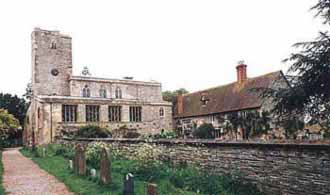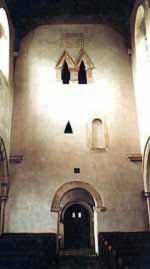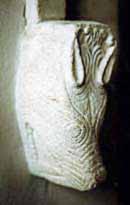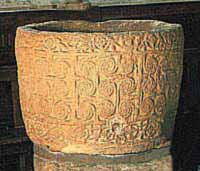
EBK Home
Kingdoms
Royalty
Saints
Pedigrees
Archaeology
King Arthur
Adversaries
For Kids
Mail David
St. Mary's Church, Deerhurst
Founded circa AD 800

 Little is known of the history of
the place. Architecturally, it appears to have been established in the
late seventh century, but there are no records of its existence before
804. That year, Aethelric, son of Earl Aethelmund of Hwicce (a Saxon
sub-kingdom covering this area) granted the priory a very large area of
land and made known his desire to be buried there. It has been suggested
that the priory was always the main church of the Hwicce and that there
Kings were traditionally buried here. It was certainly the scene of
important political events like the 1016 signing of the treaty between
Kings Edmund
Ironside and Canute
which divided England in two.
Little is known of the history of
the place. Architecturally, it appears to have been established in the
late seventh century, but there are no records of its existence before
804. That year, Aethelric, son of Earl Aethelmund of Hwicce (a Saxon
sub-kingdom covering this area) granted the priory a very large area of
land and made known his desire to be buried there. It has been suggested
that the priory was always the main church of the Hwicce and that there
Kings were traditionally buried here. It was certainly the scene of
important political events like the 1016 signing of the treaty between
Kings Edmund
Ironside and Canute
which divided England in two.
It is the church itself which tells us most about the building's story. It started as a rectangular building with a western porch in the late seventh century. A circular apse and side chapels were added early the following century. In the 9th century the apse was rebuilt as a polygon and individual chapels extended all the way down both sides. The 10th century saw the western porch extended to form a tower and it is from here that you enter St. Mary's.
 Inside, on the wall opposite, there
is an early carving of the Virgin and Child with traces of its original
paintwork still intact. It may have come from the ruined apse. As you move
forward towards the nave, turn to examine the very fine wolf-head
dripstone terminals either side of the doorway. They were very sensibly
moved here from the outside wall in 1860 to protect them from the ravages
of the British weather. There are further Saxon wolf-heads either side of
the altar. In puritan times, this was placed centrally in the church,
hence the survival
of the unique pew arrangement at the eastern end of the building. The main
features of the nave are the exceptional examples of Early English
arcading with delightfully carved corbels and capitals, but turn again and
look up at the western church wall for more Saxon details. The highest
feature is a possible dedication stone. Below this sits what is said to be
the "finest, most elaborate opening in any Saxon Church":
certainly an excellent example of Saxon pointed windows. Then there is a
bizarre triangular window next to a small Saxon doorway which opened onto
a western gallery. The old Saxon building was largely based on two
storeys. On the ground-floor is a good Saxon archway.
Inside, on the wall opposite, there
is an early carving of the Virgin and Child with traces of its original
paintwork still intact. It may have come from the ruined apse. As you move
forward towards the nave, turn to examine the very fine wolf-head
dripstone terminals either side of the doorway. They were very sensibly
moved here from the outside wall in 1860 to protect them from the ravages
of the British weather. There are further Saxon wolf-heads either side of
the altar. In puritan times, this was placed centrally in the church,
hence the survival
of the unique pew arrangement at the eastern end of the building. The main
features of the nave are the exceptional examples of Early English
arcading with delightfully carved corbels and capitals, but turn again and
look up at the western church wall for more Saxon details. The highest
feature is a possible dedication stone. Below this sits what is said to be
the "finest, most elaborate opening in any Saxon Church":
certainly an excellent example of Saxon pointed windows. Then there is a
bizarre triangular window next to a small Saxon doorway which opened onto
a western gallery. The old Saxon building was largely based on two
storeys. On the ground-floor is a good Saxon archway.
The north and south aisles house
further treasures. The western window of the latter has what remains of
the church's impressive array of old glass. St. Catherine is easily
identified with her famous wheel. She dates from around 1300. Accompanying
her is a mid 15th century depiction of St. Alphege, an 11th century monk
from the priory who rose to be Archbishop of Canterbury and was martyred
by the Danes. There are also arms of the De Clare Lords of Tewkesbury,
kneeling members of the De Hautville family and 'Suns-in-Splendour'
indicating the parish's Yorkist sympathies during the Wars of the Roses.
In the north aisle is the superb ninth century font, rescued last century
from a farmyard. It shows heavy Welsh influence being decorated mainly
with so-called Celtic Trumpet Spirals. The Strickland memorial window
nearby shows the family's turkey  crest. An ancestor is said to have
accompanied the Cabots to America and introduced the bird to Britain on
their return. Further east are the handsome brasses of the Cassey family
from Wightfield Manor. Sir John was Chief Lord of the Exchequer in the
late 14th century,
but it is the little dog at the feet of his wife which draws attention. It
is obviously the depiction of a specific family pet, for he is named as
'Terri': the only example of a named animal on any memorial brass. The
walls of the church in this area were stripped in 1973 to show the Saxon
stonework. They give a fascinating insight into the building's original
form, showing two of the doorways to the numerous side chapels or 'portici'
and holes for the wooden Saxon scaffolding!
crest. An ancestor is said to have
accompanied the Cabots to America and introduced the bird to Britain on
their return. Further east are the handsome brasses of the Cassey family
from Wightfield Manor. Sir John was Chief Lord of the Exchequer in the
late 14th century,
but it is the little dog at the feet of his wife which draws attention. It
is obviously the depiction of a specific family pet, for he is named as
'Terri': the only example of a named animal on any memorial brass. The
walls of the church in this area were stripped in 1973 to show the Saxon
stonework. They give a fascinating insight into the building's original
form, showing two of the doorways to the numerous side chapels or 'portici'
and holes for the wooden Saxon scaffolding!
See also: Odda's Chapel
